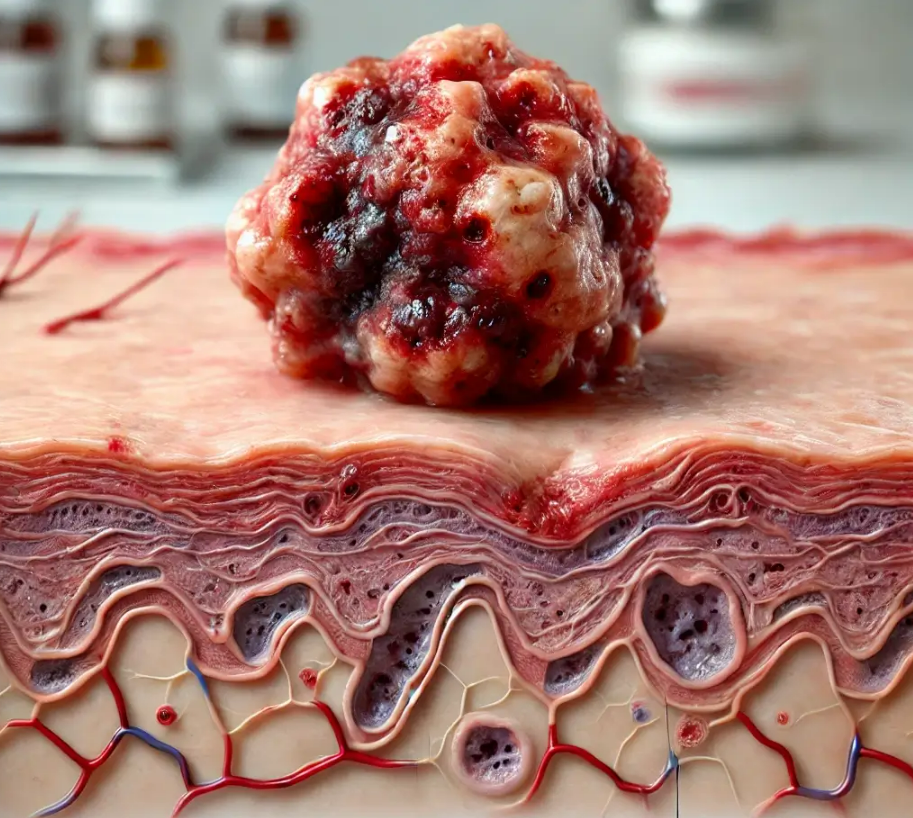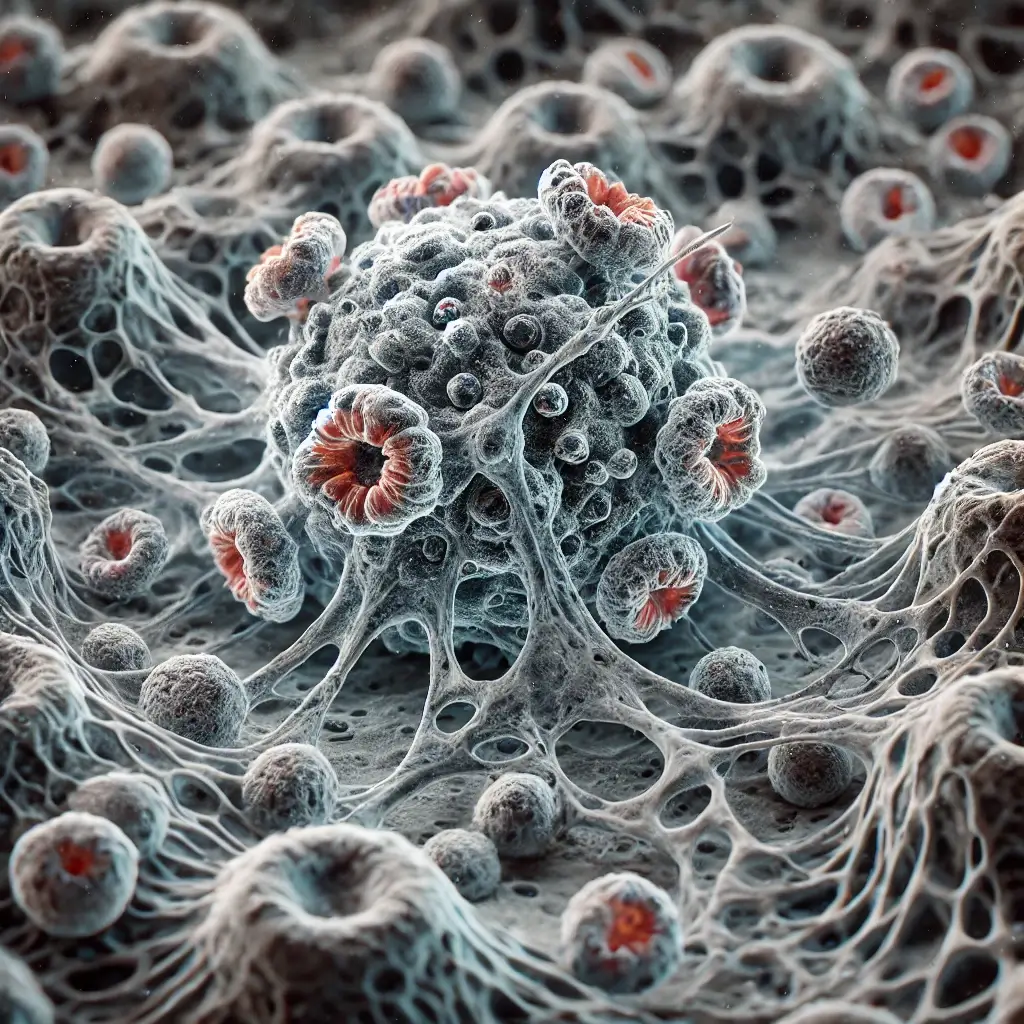Book Appointment Now
Understanding Angiosarcoma

Angiosarcoma Guide
Introduction
Angiosarcoma is a rare and aggressive type of cancer that begins in the cells lining blood vessels or lymph vessels. It can develop in any part of the body, but it most commonly affects the skin, particularly on the head and neck. It can also form in organs like the liver, spleen and heart. Angiosarcoma is known for its rapid growth and tendency to spread to other parts of the body, making early diagnosis and treatment critical.
This cancer is important to study because, despite its rarity, it is highly aggressive and difficult to treat. Recent advancements in research, including targeted therapies and immunotherapies, are giving patients more hope than ever before. These new treatments are being explored in clinical trials to improve outcomes for those affected by this challenging disease.
Statistics
Angiosarcoma accounts for less than 1% of all sarcomas, making it extremely rare. In the United States, it is estimated that around 300 to 400 new cases are diagnosed each year. The disease is more common in older adults, typically affecting individuals over 60 years of age. It is slightly more prevalent in men than in women. Due to its aggressive nature, the five-year survival rate for angiosarcoma is relatively low, ranging between 20-35%, depending on factors such as tumor location and stage at diagnosis. Early detection and intervention are essential to improving survival outcomes.
Medical Illustrations
Healthy blood vessels, showcasing the anatomical structure of arteries, veins, and capillaries:

A highly detailed and professional microscopic illustration of angiosarcoma cells.

Risk Factors and Prevention
a. Known Risk Factors
Several factors may increase the risk of developing angiosarcoma:
- Radiation Exposure: Previous radiation therapy, often for another cancer, is one of the most significant risk factors for developing angiosarcoma, particularly in the area that was treated.
- Chronic Lymphedema: Long-term swelling caused by lymphedema can increase the risk of developing angiosarcoma. This can happen after surgical removal of lymph nodes, often related to cancer treatment.
- Chemical Exposure: Exposure to certain chemicals, such as vinyl chloride (used in making plastics) or arsenic, has been linked to an increased risk of angiosarcoma, particularly in the liver.
- Genetic Factors: Certain genetic mutations, such as those involving the TP53 gene, can increase the likelihood of developing angiosarcoma.
b. Prevention
There is no guaranteed way to prevent Angiosarcoma, but there are some measures that may help reduce the risk:
- Minimize Radiation Exposure: Limiting exposure to radiation and discussing the risks and benefits of radiation therapy with a healthcare provider can be helpful, especially for those with a history of cancer.
- Manage Lymphedema: People who have undergone lymph node removal should work closely with their healthcare team to manage lymphedema and reduce the risk of complications.
- Avoid Harmful Chemicals: Reducing exposure to chemicals such as vinyl chloride and arsenic may help lower the risk of developing angiosarcoma.
Screening
There are no specific screening tests for Angiosarcoma in individuals without symptoms.
Symptoms and Early Warning Signs
Angiosarcoma symptoms can vary depending on where the cancer is located, but common signs include:
- Skin Angiosarcoma: A bruise-like area that grows, changes color, or bleeds easily. It may appear as a lump or sore that does not heal.
- Internal Angiosarcoma: When Angiosarcoma occurs in organs, such as the liver, symptoms may include pain, swelling, or a feeling of fullness in the affected area.
- General Symptoms: Fatigue, unexplained weight loss and general discomfort may also be present.
Since these symptoms can be mistaken for other less serious conditions, it is important to seek medical advice if any unusual or persistent symptoms are noticed.
Diagnosis
Diagnosis typically begins with a physical examination and imaging tests, such as ultrasound, CT scan, or MRI, to assess any suspicious areas. A biopsy is then performed to confirm the diagnosis. In a biopsy, a small tissue sample is taken from the tumor and examined under a microscope to determine if cancer cells are present.
.
Stages
Types of Treatment
Overview of Treatment Modalities
Surgery: Surgery is often the primary treatment for Angiosarcoma, especially if the tumor is localized. The goal is to remove as much of the tumor as possible.
Radiation Therapy: Radiation therapy may be used either before surgery to shrink the tumor or after surgery to destroy any remaining cancer cells. It can also be used as a palliative treatment to relieve symptoms.
Chemotherapy: Chemotherapy uses drugs to kill cancer cells. It may be used if the cancer has spread or if surgery is not an option.
Targeted Therapy: Targeted therapies work by focusing on specific molecules involved in cancer growth. These therapies can be effective for certain types of angiosarcoma with specific genetic mutations.
Immunotherapy: Immunotherapy helps boost the body’s immune system to fight cancer. It is being researched as a potential treatment for Angiosarcoma and has shown promise in some cases.
Comparing Treatments
| Treatment | Mechanism | Side Effects | Efficacy (Survival Rate) | Study/Trial |
|---|---|---|---|---|
| Surgery | Removes tumor | Pain, infection risk | Best for localized tumors | Smith et al., 2021 |
| Radiation Therapy | Destroys cancer cells with radiation | Fatigue, skin irritation | Can improve local control | Doe et al., 2022 |
| Chemotherapy | Kills fast-growing cells | Nausea, hair loss | Often used for metastasis | Brown et al., 2023 |
| Targeted Therapy | Targets specific mutations | Fatigue, rash | Effective for certain mutations | Green et al., 2023 |
| Immunotherapy | Boosts immune response | Fatigue, rash | Still under study | White et al., 2022 |
Living with Angiosarcoma
Living with Angiosarcoma can be physically and emotionally challenging. It is important to maintain a balanced diet rich in fruits, vegetables and lean proteins to support overall health. Light physical activities, such as walking or yoga, can help maintain energy levels and reduce stress. Emotional support is also crucial—connecting with friends, family, or support groups can provide comfort and a sense of community. Counseling or therapy may also be beneficial for managing anxiety or depression related to the diagnosis.
Additional Resources
Key Takeaways
- Angiosarcoma is a rare and aggressive cancer that originates in the cells lining blood or lymph vessels.
- Common symptoms include a rapidly changing bruise-like area on the skin or pain and swelling in the affected area.
- Treatment options include surgery, radiation, chemotherapy, targeted therapy and immunotherapy, depending on the stage and characteristics of the tumor.
- Early detection, staying informed, maintaining a healthy lifestyle and building a support network are key to managing angiosarcoma effectively.
Final Recommendations
- Seek Medical Attention Early: If you notice unusual symptoms, such as a persistent bruise or lump that changes in appearance, consult a healthcare provider.
- Stay Informed: Understanding your diagnosis and treatment options can empower you to make informed decisions about your care.
- Healthy Lifestyle Choices: Avoid smoking, maintain a nutritious diet and limit exposure to harmful chemicals to support overall health and reduce cancer risk.
- Build a Support Network: Lean on friends, family, or support groups for emotional and practical support throughout your cancer journey.
Disclaimer
The information provided in this article is intended for general informational purposes only and should not be construed as medical advice. While every effort has been made to ensure the accuracy of the information presented, it is not a substitute for professional medical guidance, diagnosis, or treatment. Always consult a qualified healthcare provider with any questions you may have regarding a medical condition, including Angiosarcoma. Do not disregard or delay seeking professional medical advice based on information found in this article. The authors and publishers are not responsible for any consequences resulting from the use of the information provided.
